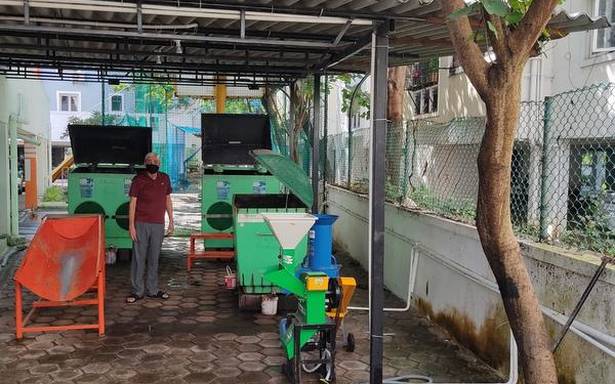A gated community on the IT corridor invests in two shredders — which are essentially farm implements — to improve the composting process on its premises
A few months ago, three composters at a gated community on the IT Corridor were harshly overshadowed by a dark side of human nature: faulting others for one’s own failing. There were murmurs about an occasional icky smell, felt by flats within whiffing range of the composters. Studying the issue, the waste management team at the community identified the door the blame had to be laid at. It was in fact not just one door, but all doors, theirs included. The entire community was declared at fault in the matter — for thoughtlessly handing over organic waste. And together, they have invested in a solution.
“In your house, there is a cauliflower, half of which has gone bad and that part goes unthinkingly into the green bin. Chunky pieces of organic waste take time to compost,” says Rakesh Ohri, president, The Central Park South (TPCS) residents’ association.
Realising that awareness exercises in this matter would be unreliable ground, the TCPS team rejected that option. Figuring out what to do with that “chunky cauliflower” led them to Appaswamy Springs, a gated community in Thiruvanmiyur, which had cut theirs down to size, without rapping its residents on the knuckles for it.
They had installed two shredders as “assistants” to the composters — one would mash any chunky cauliflower and their allies to the consistency of a paste; and the other would chew dry leaves to the granularity of powder.
TCPS did what the Springs community had done three years ago: source two shredders from a dealer in Bengaluru. The shredders were joined by a cost-effective “segregator” fabricated locally.
Rakesh discloses that these two shredders are essentially farm implements, but lend themselves handsomely to meeting composting challenges in an urban environment.
“The wet waste that comes here has some things that need to be dealt with specially — wisps of paper, pieces of plastics, heavy big bones and so on,” says Rakesh, gesturing to the ludicrously uncomplicated segregator. Imagine a long concave-shaped GI sheet, and you have it right in front of your eyes. It is designed to be in a sloping position.
“The wet waste is spread out on the metal sheet. Doing so drains out excess water and also helps pick out the small unwanted things. More importantly, the chunks of waste are removed and deposited in the wet-waste shredder, which chops them and makes a fine paste of them,” explains Rakesh.
Sumitha Iyer, committee lead for FOMRRA Swatch Bharat and a TCPS resident, notes: “There are many factors to composting. One is weather, which includes adequate sunlight. And then whether you are putting the wet waste in properly. The size of the organic discard also makes a difference. We thought a shredder would help, and it has helped.”
She observes how shredding chunky pieces of wet waste has addressed a related issue.
“We noticed that the composters were also getting filled soon, leaving us with little space to add more organic waste. If you fill the composters to the brim with wet waste, composting in the lower layers will take place slowly,” she says.
By reducing chunky pieces to paste, the wet-waste shredder contributes to creating more space in the composters.
Sumitha remarks that keeping the layers free of chunks of wet waste ensures that microbial activity happens uniformly across these layers, thereby preventing odours.
In addition to the accelerator (TCPS uses inoculum) that speeds up the composting process, sawdust is applied to the wet waste bedded in the composter to drain out excess liquid, which also checks odours.
With the advent of the leaf shredder — sawdust is replaced with leaf powder, most of the time.
“Dry leaves is usually available on our premises. When it is not available, we have sawdust to fall back on. We get raw sawdust, which is not of treated wood. Treated wood would again have chemicals and its presence would not help the composing process,” observes Sumitha.
On the rationale behind investing in a leaf shredder, Rakesh says: “People may say leaves mulch on their own. They do, but they take time to do so.”
Sumitha weighs in: “There are communities that compost only with raw stuff. Here, we use everything — cooked food and uncooked food. When cooked food comes into the picture, with its oil and everything else, there are problems for microbial action. So, sawdust helps deal with the moisture. Leaf powder is good enough. Besides making the process easier, leaf powder spares us the trouble of having to figure out what to do with the leaves that have accumulated on our premises.”
Source: Read Full Article

